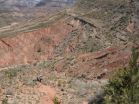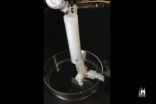(Press-News.org) The growing and justified concern about the current global warming process has kindled the interest of the scientific community in geological records as an archive of crucial information to understand the physical and ecological effects of ancient climate changes. A study by the UPV/EHU's Palaeogene Study Group deals with the behaviour of the sea level during the Palaeocene–Eocene Thermal Maximum (PETM) 56 million years ago and has ruled out any connection. The study has been published in the journal Palaeogeography, Palaeoclimatology, Palaeoecology.
"The fall in sea level did not unleash the emission of greenhouse gases during the Palaeocene–Eocene Thermal Maximum (PETM)," pointed out Victoriano Pujalte, lecturer in the UPV/EHU's Department of Stratigraphy and Palaeontology, and lead researcher of the study.
The Palaeocene–Eocene Thermal Maximum (PETM) was a brief interval (in geological terms, it "only" lasted about 200,000 years) of extremely high temperatures that took place 56 million years ago as a result of a massive emission of greenhouse gases into the atmosphere. The global temperature increase is reckoned to have been between 5º C and 9º C. It was recorded in geological successions worldwide and was responsible for a great ecological impact: the most striking from an anthropological point of view was its impact on mammals, but it also affected other organisms, including foraminifera and nannofossils (marine microorganisms that are at the base of the trophic chain) and plants.
However, what actually caused this warming remains a controversial issue. The most widely accepted hypothesis suggests that it was due to the destabilising of methane hydrates that remained frozen on ocean floors. "Some authors, like Higgins and Schrag (2006), for example, proposed that a fall in sea level could have caused or co-contributed towards the unleashing of the emission of methane or CO2," pointed out Victoriano Pujalte, lecturer in the UPV/EHU's Department of Stratigraphy and Palaeontology, and lead researcher in the study. According to this hypothesis, "the marine sediments that were submerged in the sea were exposed when the sea level fell, and were responsible for the CO2 emissions," he added. That is what, to a certain extent, prompted this study. Others not only reject that possibility but also the fall in sea level itself. "We set out to try and establish the behaviour of the sea level during that time interval, the PETM," said Pujalte.
There is no cause-effect relationship
The studies were carried out mainly in the Pyrenees between Huesca and Lérida, specifically in the Tremp-Graus Basin, and also in Zumaia (Gipuzkoa, Basque Country). The Palaeocene-Eocene rocks have outcropped extensively in both areas, in other words, exposed on the surface, and they represent a whole range of ancient atmospheres, both continental and marine. "They provide a unique opportunity to explore the effects of changes in sea level and to analyse their effects," added Pujalte.
The most useful indicators are the stable oxygen and carbon isotopes. The oxygen ones provide information on palaeotemperatures, but any sign of them can only be retrieved in deep-sea sample cores. The carbon isotopes provide data on variations in CO2 content in the atmosphere and in the oceans, and they can also be retrieved in ancient rocks that have outcropped in above-ground plots of land. In general, the variations of both isotopes run parallel, given that an increase in the proportion of CO2 is coupled with an increase in temperature.
The results obtained indicate that the PETM was in fact preceded by a fall in sea level, the size of which is estimated to have been about 20 metres and the maximum descent of which probably occurred about 75 million years before the start of the PETM. "However, it is doubtful that the descent was the cause of the PETM, although it could have contributed towards it," pointed out Victoriano Pujalte. "They occurred at the same time, but there is no cause-effect relationship."
Furthermore, the researchers observed that the rise in the sea level continued after the PETM, when the global temperature returned to normal levels. "Its origin was not only caused, therefore, by the thermal expansion of the oceans linked to the warming," said Pujalte. "It is suggested that the most likely cause of it was the volcanic activity documented in the North Sea during the end of the Palaeocene and start of the Eocene; this activity was related to the expansion of the oceanic ridge in the North Atlantic," he concluded.
INFORMATION: END
The causes and consequences of global climate warming that took place 56 million years ago studied
2014-03-25
ELSE PRESS RELEASES FROM THIS DATE:
A non-invasive, rapid screening method for Alzheimer's disease
2014-03-25
The apolipoprotein E gene ε4 allele is considered a negative factor for neural regeneration in late-onset Alzheimer's disease cases. Apolipoprotein E genotyping is crucial to apolipoprotein E polymorphism analysis. Peripheral venous blood is the conventional tissue source for apolipoprotein E genotyping polymorphism analysis. Blood yields high-quality genomic DNA and can meet various research purposes. However, because of invasiveness, taking blood samples decreases compliance among the elderly, especially neuropsychiatric patients. Moreover, blood specimens often ...
Small peptides as potential antibiotics
2014-03-25
Drug approval requires a deep understanding of the mechanism of action
The team of Julia Bandow, who heads the RUB's Junior Research Group Microbial Antibiotic Research, has been studying the MP196 peptide as a representative of a group of very small positively charged peptides that consist of some four to ten amino acids. Earlier studies had shown that MP196 is efficient against various bacteria, including particularly problematic multi-resistant pathogens that frequently cause sepsis. How MP196 kills bacteria remained unclear. However, in order for a new substance to ...
VTT: Building to take note of individual human thermal comfort
2014-03-25
Because people in developed countries spend about 90% of their time indoors, their sense of warmth becomes one key comfort factor for interior spaces. VTT Technical Research Centre of Finland has developed a new method for assessing the individual thermal comfort experienced by different user groups. The design of energy efficient buildings – such as day care centres, schools, offices and homes for the elderly – should pay more attention in future to the thermal comfort of user groups according to real needs.
The new method developed for assessing thermal comfort (Human ...
Simple, like a neutron star
2014-03-25
In how many ways can one describe an object? Take an apple: by just looking at it we can easily estimate its weight, shape and colour but we are unable to describe it at any other level, for example, to evaluate the chemical composition of its flesh. Something similar also applies to astronomical objects: until today one of the challenges facing scientists was to describe neutron stars at the nuclear physics level. The matter these stars are made up of is in fact extremely complex, and several complicated equations of state have been proposed. However, to date there is ...
New technique brings us closer to HIV and Hepatitis C vaccines
2014-03-25
Plans for a new type of DNA vaccine to protect against the deadly HIV and Hepatitis C viruses have taken an important step forward, with University of Adelaide researchers applying for a patent based on groundbreaking new research.
Professor Eric Gowans from the University's Discipline of Surgery, based at the Basil Hetzel Institute at the Queen Elizabeth Hospital, has submitted a patent application for what he describes as a relatively simple but effective technique to stimulate the body's immune system response, thereby helping to deliver the vaccine.
While pre-clinical ...
Catheter innovation destroys dangerous biofilms
2014-03-25
DURHAM, N.C. -- For the millions of people forced to rely on a plastic tube to eliminate their urine, developing an infection is nearly a 100 percent guarantee after just four weeks. But with the help of a little bubble-blowing, biomedical engineers hope to bring relief to urethras everywhere.
About half of the time, the interior of long-term urinary catheters become plagued by biofilms -- structures formed by colonies of bacteria that are extremely difficult to kill. Once established, it is only a matter of time before the biofilm becomes a welcoming host for other, ...
Doxorubicin alone or with ifosfamide for treating soft tissue sarcoma?
2014-03-25
An EORTC study published in The Lancet Oncology does not support administration of intensified doxorubicin and ifosfamide for palliation of advanced soft tissue sarcoma, unless the objective is to shrink the tumor.
Dr. Ian Judson of the Royal Marsden Hospital in London and coordinator of this study says, "Our clinical trial was designed to compare combination treatment with doxorubicin and ifosfamide to treatment with doxorubicin alone, and our results show that the combination chemotherapy did not improve overall survival. So, if the goal of treatment is to control the ...
Leading surgeons warn against media hype about tracheal regeneration
2014-03-25
Beverly, MA, March 24, 2014 – Reports of the two earliest tissue-engineered whole organ transplants using a windpipe, or trachea, created using the patient's own stem cells, were hailed as a breakthrough for regenerative medicine and widely publicized in the press. However, two leading transplant surgeons in Belgium warn of the dangers of media attention, and urge that tracheal bioengineering be demonstrated as both effective and safe before further transplants take place. Their views are published in an Editorial in The Journal of Thoracic and Cardiovascular Surgery, an ...
Research study takes deeper look at the role of gut microbes in the immune system
2014-03-25
LOS ANGELES (March 24, 2014) – New research suggests that gut microorganisms do not merely influence immune cell function, but also support the production of immune cells that form the first line of defense against infection. By understanding the mechanisms responsible for maintaining and replacing immune cells, researchers hope to one day develop targeted therapies to support and boost immune function in humans.
Study investigators from the Regenerative Medicine Institute at Cedars-Sinai collaborated with the Mount Sinai School of Medicine and lead institution — the ...
Replacing insulin through stem cell-derived pancreatic cells under the skin
2014-03-25
LA JOLLA, Calif., March 25, 2014 – Sanford-Burnham Medical Research Institute (Sanford-Burnham) and UC San Diego School of Medicine scientists have shown that by encapsulating immature pancreatic cells derived from human embryonic stem cells (hESC), and implanting them under the skin in animal models of diabetes, sufficient insulin is produced to maintain glucose levels without unwanted potential trade-offs of the technology. The research suggests that encapsulated hESC-derived insulin-producing cells hold great promise as an effective and safe cell-replacement therapy ...

